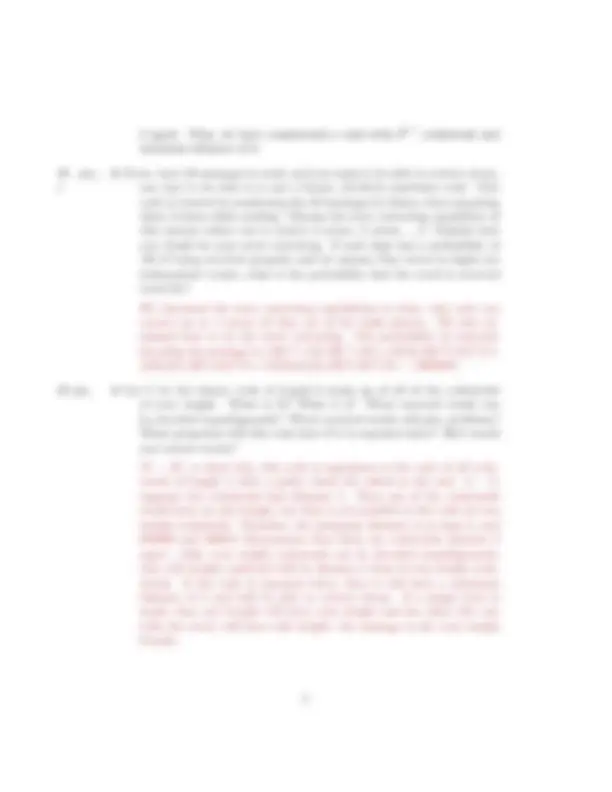



Study with the several resources on Docsity

Earn points by helping other students or get them with a premium plan


Prepare for your exams
Study with the several resources on Docsity

Earn points to download
Earn points by helping other students or get them with a premium plan
Community
Ask the community for help and clear up your study doubts
Discover the best universities in your country according to Docsity users
Free resources
Download our free guides on studying techniques, anxiety management strategies, and thesis advice from Docsity tutors
Material Type: Assignment; Class: CODING THEORY; Subject: Mathematics; University: University of Richmond; Term: Spring 2009;
Typology: Assignments
1 / 2

This page cannot be seen from the preview
Don't miss anything!


Math 350 Spring, 2009
HOMEWORK #
Do 50 points of the following problems (due 1/19/09).
15 pts. 1 The Chemical Abstract Service uses the following scheme for registry num- bers: a 1 a 2... a 7 are the identification digits, and the check digit is a 8 = 7 · a 1 + 6 · a 2 + 5 · a 3 + 4 · a 4 + 3 · a 5 + 2 · a 6 + 1 · a 7 (modulo10). What mistyped digits will not be detected? What about transpositions? This scheme will pick up any transposition. Suppose ai and ai+1 are transposed: then the contribution to the sum will be iai+1 + (i + 1)ai instead of iai + (i + 1)ai+1. If we suppose they are equal, that implies that iai+1 + (i + 1)ai = iai + (i + 1)ai+1, or ai = ai+1. However, that really means that there was not a transposition error (which only occurs when consecutive numbers are not equal). For mistyped digits, any even term will mistake a mistype of magnitude
15 pts. 2 Generalize problem 1.5, p.10, to a 3-ary (k,M,2)-code (do parts (i) and (ii)). A 3 (k, 2) = 3k−^1. We first argue that A 3 (k, 2) ≤ 3 k−^1. Suppose we have a code of length k whose minimum distance is 2. If we puncture the last component, the remaining code must have a minimum distance of 1 implying that all these codewords of length k − 1 are distinct. Since there are 3k−^1 distinct codewords of that length, that shows the upper bound. In order to construct a code with that many codewords, take the list of all 3-ary codewords of length k − 1. Add a parity check bit on the end (make the sum of all k digits add to 0 mod 3). If the first k − 1 bits are only different in one place, then those codewords must have a different parity check bit implying a distance of 2. If the first k − 1 bits are different in 2 or more places, then we don’t need to worry about the parity check bit because the codewords are already at least
2 apart. Thus, we have constructed a code with 3k−^1 codewords and minimum distance of 2.
30 pts., 3 If you have 16 messages to send, and you want to be able to correct errors, ? one way to do that is to use a binary (12,16,3) repetition code. This code is created by numbering the 16 messages in binary, then repeating them 3 times while sending. Discuss the error correcting capabilites of this system (when can it correct 2 errors, 3 errors, ...)? Explain how you would do your error correcting. If each digit has a probability of .99 of being received properly and we assume that errors in digits are independent events, what is the probability that the word is received correctly? We discussed the error correcting capabilities in class: this code can correct up to 4 errors (if they are in the right places). We also ex- plained how to do the error correcting. The probability of correctly decoding the message is (.99)^12 + 12(.99)^11 (.01) + 12(9)(.99)^10 (.01)^2 /2 + 12(9)(6)(.99)^9 (.01)^3 /6 + 12(9)(6)(3)(.99)^8 (.01)^4 /24 = .9988078.
20 pts. 4 Let C be the binary code of length 6 made up of all of the codewords of even weight. What is M? What is d? What received words can be decoded unambiguously? What received words will give problems? What properties will this code have if it is repeated twice? How would you correct errors? M = 32: to show this, this code is equivalent to the code of all code- words of length 5 with a parity check bit added at the end. d = 2: suppose two codewords had distance 1. Then one of the codewords would have an odd weight, but that is not possible in the code of even weight codewords. Therefore, the minimum distance is at least 2, and 000000 and 000011 demonstrate that there are codewords distance 2 apart. Only even weight codewords can be decoded unambiguously. Any odd weight codeword will be distance 1 from 6 even weight code- words. If the code is repeated twice, then it will have a minimum distance of 4 and will be able to correct errors. If a single error is made, then one 6-tuple will have even weight and the other (the one with the error) will have odd weight: the message is the even weight 6-tuple.